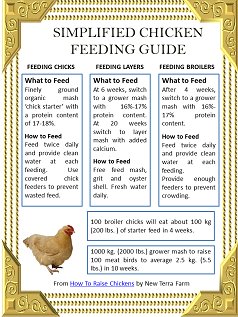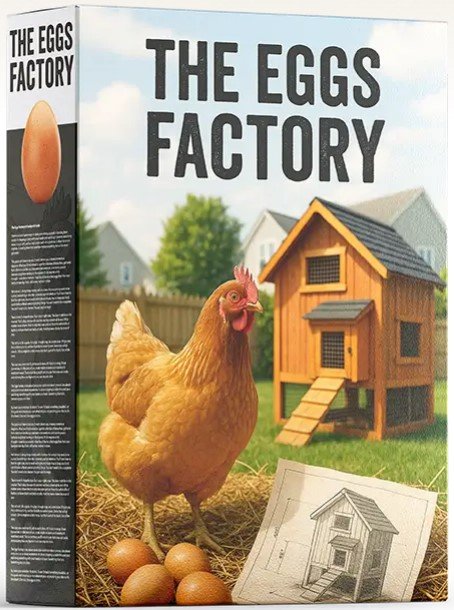Raising chickens for eggsWe've been raising chickens for eggs for more than 20 years at New Terra Farm. There is nothing like your own free-range organic eggs, fresh from your backyard chicken coop. Follow along on this page to learn how we manage our flock.
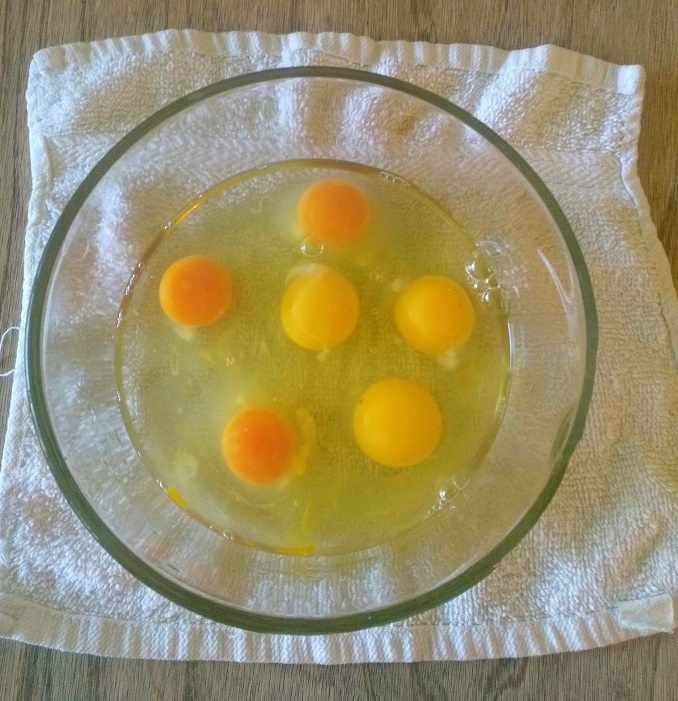 Here's why we've been raising laying hens; our eggs vs store-bought 'organic' Here's why we've been raising laying hens; our eggs vs store-bought 'organic'Choices: starting with day-olds, hatching eggs, or ready-to-lay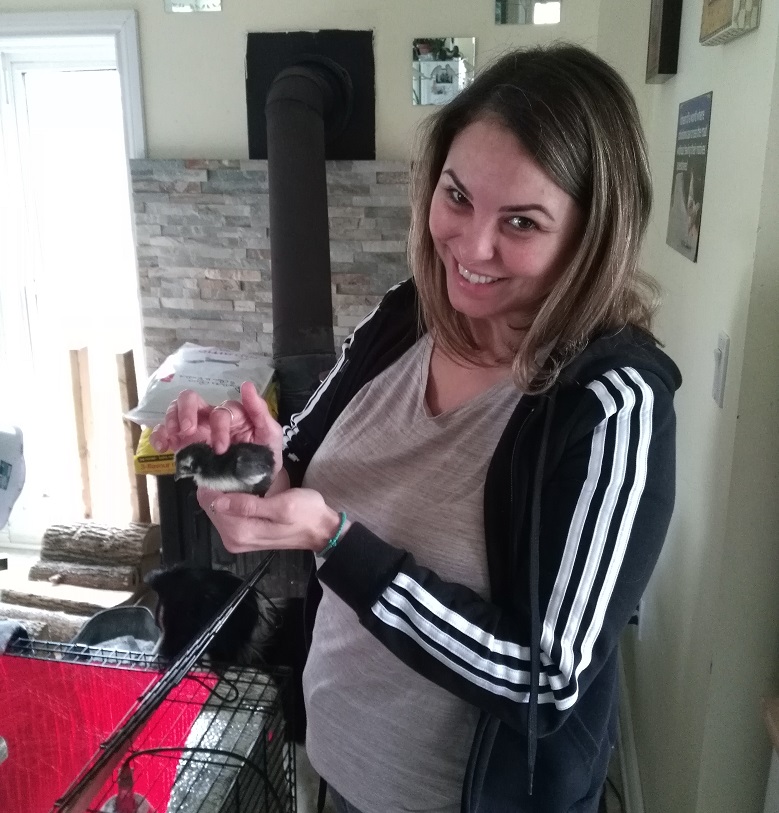 A couple cute chicks - my daughter with one of the new hatch A couple cute chicks - my daughter with one of the new hatchYou can begin raising chickens for eggs with day-old chicks from a hatchery, or by hatching eggs yourself, or you can buy ready-to-lay pullets from your local supplier. We have done all three; and when we had a flock of Black Australorps, we used to let a couple hens go broody every spring to hatch a replacement flock for us. We bought some ready-to-lay pullets one year when the foxes wiped out our laying flock (but the final score in that game was Scott - 2, foxes - 0. I got one with the .410 and my border collie got the other). The hens were a standard brown egg laying breed, and produced adequately. We weren't crazy about the fact they had been beak trimmed, and of course they weren't raised organically. The cost
versus other options is about the same. You might spend $10 for a
ready-to-lay pullet, and maybe a little less to buy a day-old chick and raise
it to laying age, 20 weeks or so. We bought some day-olds at the same time we acquired the ready-to-lay pullets, intending them to be the replacement flock. See more below. There are a couple advantages to raising day-olds. First, you will probably have a wider selection of breeds available. Second, you can select the sexes you want. If you don't want to deal with the roosters, this is a good choice. Be aware also that many hatcheries require orders several weeks in
advance, and that chicks may be available only at certain times of the
year. Check with your local hatchery or feed store to confirm
availability.
Hatching your own eggs is fun, especially if you have little kids to entertain. We bought a small incubator that could handle up to 2 dozen eggs. It's not that difficult to hatch your own eggs, we generally had a success rate of 90% or greater. If you have hens and a
rooster, you can collect fertile eggs for up to
about a week. Keep the cleanest eggs (don't wash them) in a cool place,
preferably in egg cartons pointy-side down. We put the cartons in a
bucket at the top of the stairs to our basement, a good cool spot in the
spring. Follow the directions of the equipment manufacturer. Here's a link with some good information about incubating equipment. One challenge with hatching eggs is, you will get on average 50% roosters. We dealt with this by culling all but a couple roosters in the fall. They went into the freezer. When we had an excess of roosters of the smaller breeds, I did the same as I do with old hens. I skinned the carcasses, cut off the breasts and legs, and pressure-canned them in quart jars. Makes the most awesome potted chicken you ever tasted. One 3-4 lb bird will fit in one jar. We don't hatch out eggs anymore ourselves, but we have supplied hatching eggs to a neighbour with a large incubator. This spring she hatched several batches of our eggs for us and a couple farming friends. Prices range from one to two dollars per hen for the standard white or brown egg-layer, up to several dollars per chick for the more unusual or heritage breeds such as Barred Rocks or Black Australorps. Breeds of chickens we have raised for eggs
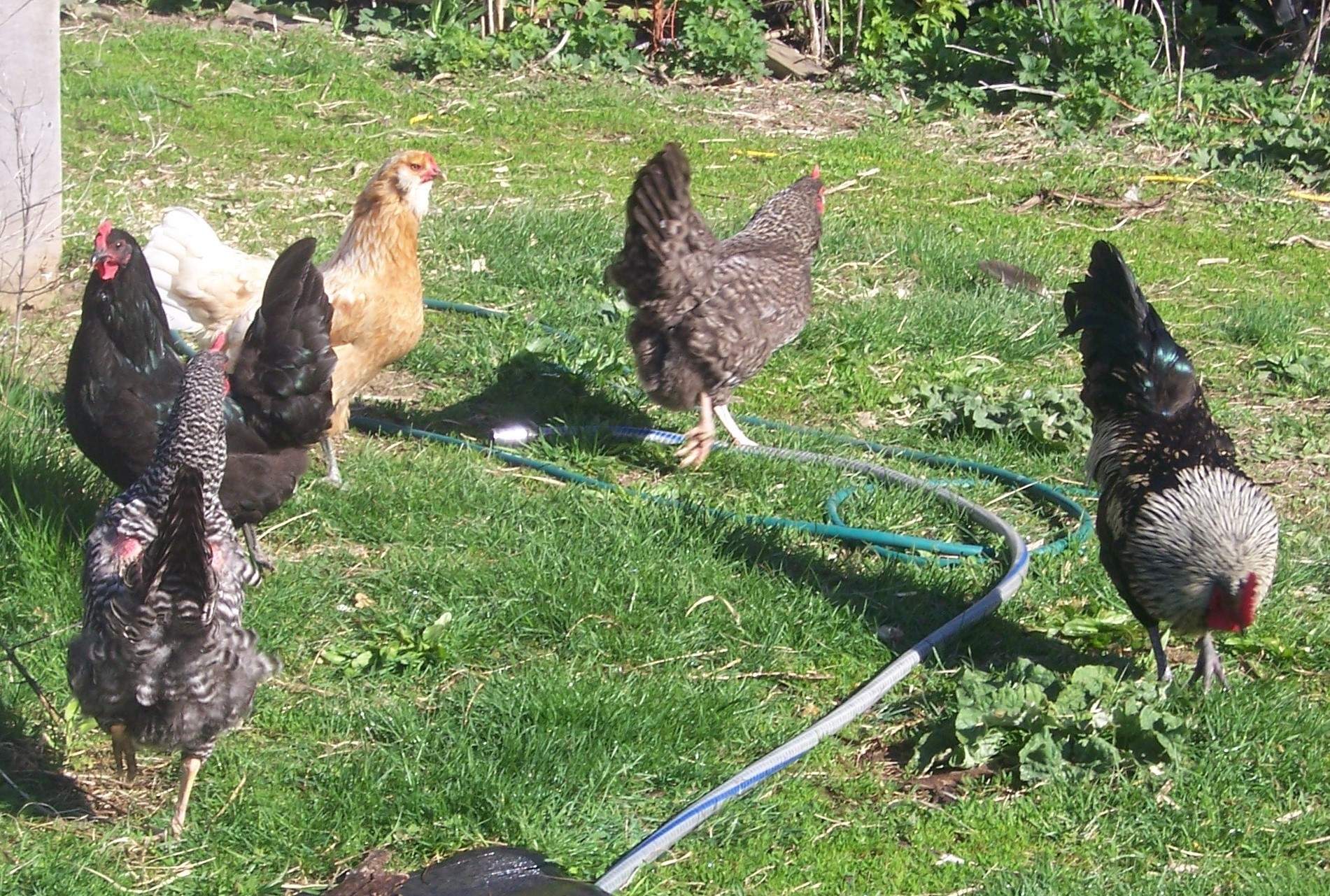 A few of our birds - Black australorps, buff orpington, barred rock, and a silver dorking rooster A few of our birds - Black australorps, buff orpington, barred rock, and a silver dorking roosterWe acquired our current mixed flock of Barred Rocks, Australorps, and Rhode Island Reds as day-old chicks. Of the three, the Black Australorp is the closest to a real 'dual-purpose' bird. They will lay 200+ eggs a year, and also produce a 5 or 6 lb. carcass when you are ready to retire them. Barred Rocks are smaller than Australorps, and Reds are the smallest of the three. All produce more than adequate quantities of eggs. Our current flock of 14 hens are into their first laying season, and we get about 10 eggs a day on average. Lots for us and the kiddies and a few we sell or barter to friends and neighbours. I read discussions about temperament in birds; I can't say I've noticed much difference in the breeds we've raised. Our mixed flock seems to get along OK, and will readily come up to us for treats (something my grandkids love). We keep our current mixed flock mostly for the variety. If I had to pick only one breed, it would probably be the Australorps, just because of the size of the carcass. I like roasters on the bigger side. Raising chickens for eggs - care and feedingBefore you pick up your chicks, you need to get the equipment, supplies and feed to care for them. You will need a way to keep your chicks warm and dry for the first several weeks. We use broody boxes like in the picture below. A heat lamp keeps the birds warm and the screened opening makes sure they don't overheat. The boxes keep out rodents, too.
We start all our chickens, both meat birds and egg laying birds, on organic chick starter. This is a fine-ground mash with a 18-20% protein content, and if bought from a mill will generally have added minerals. Figure on 1 kg (approx 2 lbs) of chick starter per bird for the first three weeks. In other words, the 25-kilo bags I buy will feed 25 birds for 3 weeks. We keep the birdies on this mix for about 5 weeks, then gradually switch them over to an organic grower ration. In about 20 weeks the pullets will be ready for laying, so we put them on a layer ration with extra calcium. We also free feed oyster shell in the chicken coop, and add a pan of grit in the winter. Once summer comes, we put the laying hens on the same grower ration as our meat birds. The free-ranging birds will supplement their diet with whatever they can scrounge - bugs, grass, weed seeds, and small gravel for grit.. This lets me buy feed in bulk and save about 10%, without affecting egg production. This adds up to a couple hundred bucks a year. Be careful not to overfeed. We have had success feeding the chicks twice a day, with enough food to keep them eating for 15 minutes or so.
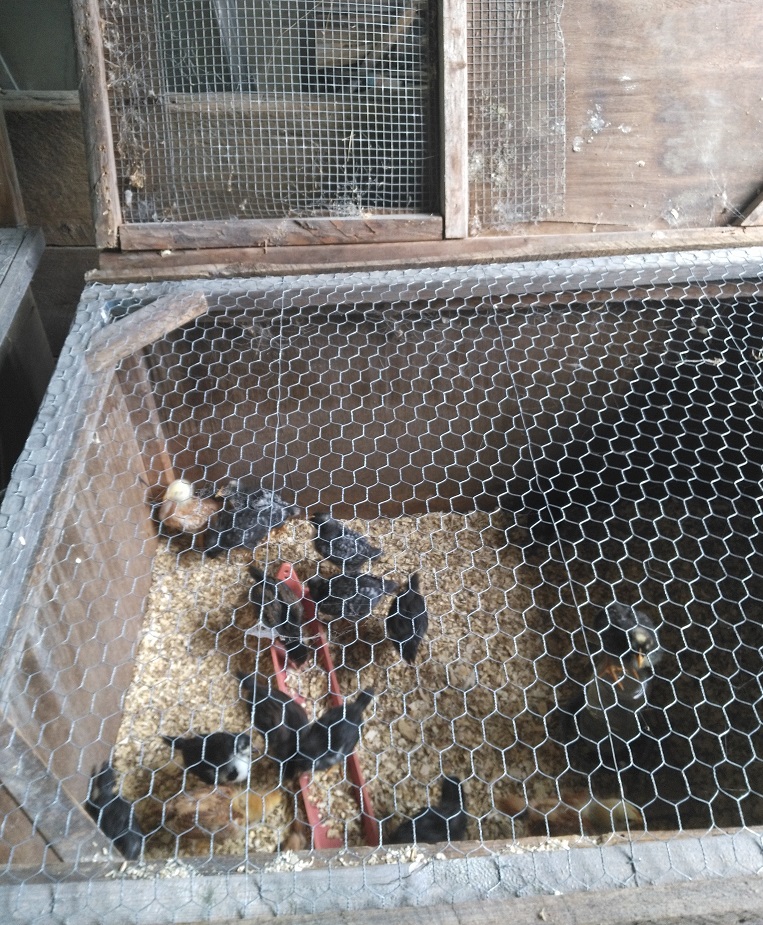 We made a screen cover for warm days. We close the cover and turn on the heat lamp on cool nights We made a screen cover for warm days. We close the cover and turn on the heat lamp on cool nightsWe use the same heated and ventilated broody boxes that we built for our meat birds for raising laying hens. The boxes are 3'x4' by 2' high, and have a hardware cloth section in the top for ventilation. A heat lamp keeps the little chickies warm. We've put up to about 30 chicks in one of these boxes. In especially cold weather we can cover the ventilation screening with a tarp or feed bag to hold more heat in. We put a one or two-inch layer of wood shavings in the box, and add fresh shavings every few days as needed. A one gallon waterer and a couple small feeders complete the equipment. Raising chickens for eggs - care in the coopWe have a permanent coop for our laying
birds. This was an old small outbuilding, with a solid floor and roof, dimensions about 12' x 14' .We put up some nest boxes and cut some poles from our bush for roosts. We covered the old log structure with some rough cut pine to help block drafts (and pretty it up a little) We have 6 nest boxes raised a couple feet from the floor. Each box is about 14" wide and a foot deep. Our 14 hens seem to only use the top rank of boxes though. We use wood
shavings in the nest boxes and also on the floor. We clean the coop out
spring and fall and compost the results for use in our gardens. Keeping
their environment clean is a key to successfully raising laying hens. Allow at least 4-5 square feet of space in the coop for each hen.  Our old coop got a facelift and we added power so we could have light Our old coop got a facelift and we added power so we could have light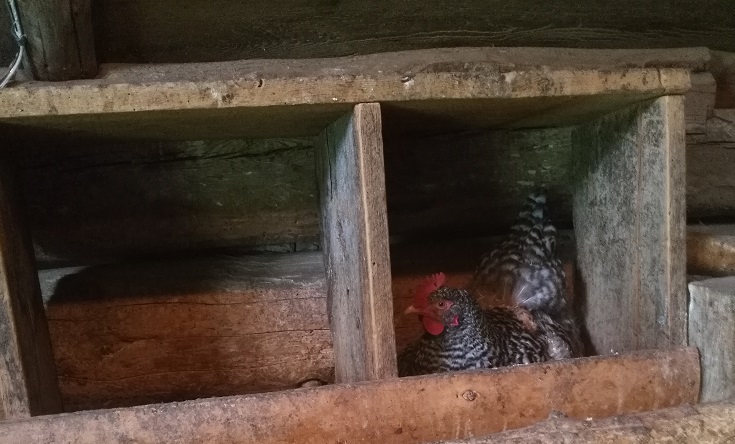 One of our Barred Rock girls hard at work One of our Barred Rock girls hard at workIf you are looking for a small portable coop for raising chickens for eggs in a backyard, I did a review of free chicken coop plans here Raising chickens for eggs - it's all about the eggs!
Now we get to the whole point of raising chickens for eggs ;-) We collect eggs daily. Your hens will have
completed lay by about noon. We usually wash our eggs every couple days
and refrigerate them, unless they are for hatching (see above). We put a
'best before' date of about 5 weeks from the date we pick them up on each carton. If you keep your nest boxes clean, most eggs can just be brushed clean and put in cartons to store. If they are especially soiled put a drop of dish soap and a little vinegar in a bowl of warm water, and clean the eggs with a cloth. Dry them off and put in the cartons to store. Raising chickens for eggs is a profitable sideline for a small farm or the organic market gardener. Our CSA customers bought all the eggs we can produce; we were lucky to keep a dozen a week for our own use during the busy summer season. Organic free-range eggs command a premium price; once your customers taste, them they will keep coming back for more. Free Chicken Feeding GuideChicken Feeding Guide We've made feeding your birdies easier with our free Simplified Chicken Feeding Guide. Over the years we have evolved an simple way to feed chicks, layers and meat birds. Our birds do very well with this method. My farm is 52 acres. How about if you just have 50 sq. ft.?One of my joys at New Terra Farm is going out to my chicken coop every day to collect fresh, organic eggs. If you’ve ever found yourself questioning the rising cost and declining quality of store-bought eggs, you’re not alone; and there’s a practical solution, even if you don't own a farm. I didn't write this one but it's a great resource anyway. If you can find 50 sq. ft. on your property this is a straightforward, hands-on guide for setting up a compact backyard chicken coop that can supply your household with a consistent flow of fresh, nutrient-rich eggs. It’s designed for people who value food security, self-sufficiency, and a healthier lifestyle, even if they have no prior experience with raising chickens. This system walks you through building a durable coop using common, affordable materials—typically for under $100. It’s low maintenance, fits in a small space (around 50 sq ft), and requires only a few minutes of attention each day. The guide includes detailed plans and practical tips for everything from predator-proofing to choosing quiet, productive breeds. If you’re looking to reclaim control over your food source, reduce grocery bills, or even create a modest income by selling excess eggs, The Eggs Factory offers a practical, community-tested solution to get started. For the Small Grower and HomesteaderUp your self-sufficiency game with the Bootstrap Books series And, because there is more to survival than just food, here's a resource with literally HUNDREDS of great tips and low-cost projects for your homestead. The Self Sufficient Backyard. Highly recommended.
|
See Something You Like? Share!
Questions, comments, stories to tell about raising chickens for meat?
Share your question, or comment, or story about raising meat chickens.
I'm an affiliate for some products I promote on this site. This means I get a small commission for a product you buy through a link on one of my pages. This doesn't cost the buyer anything, but provides me an additional income to help support these pages.
Recent Articles
-
Best Chicken Coop and Accessories for Small Farms and Homesteads
Nov 15, 25 03:35 PM
Looking for the best chicken coop? Here are the top coops, accessories, nest boxes, and gear to build a safe, productive poultry setup. -
Farm grown reviews of products recommended by New Terra Farm
Nov 07, 25 06:25 AM
Find great farm and garden products in my farm grown reviews -
Community Supported Agriculture Marketing Ideas To Sell Out The Season
Nov 05, 25 05:18 AM
Authentic Community Supported Agriculture marketing ideas to grow loyalty, boost sign-ups, and sell out your CSA every year
